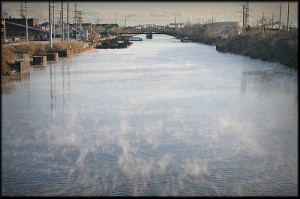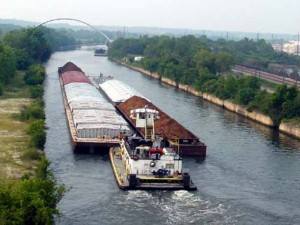They are deadly for aquatic life and take years of pollution to develop, yet dead zones can be created in a flash by bubbling nitrogen through a lake.

A section of the Chicago Sanitary and Shipping Canal. Some scientists say it’s never been a migratory route for native fish and a hypoxic zone along the canal would not result in major fish kill. Image: Joe Balynas, flickr
Now some scientists say this technique could deter the Asian carp from using the Chicago Sanitary and Ship Canal to enter the Great Lakes. Researchers fear invasion by the voracious fish would cause untold environmental and economic disasters.
They envision blocking them with a zone of such low oxygen that fish and most plants can’t survive by flushing nitrogen in the waterway that connects Lake Michigan to the Mississippi River.
“The gas bubbles attract and dissipate oxygen from the water,” said Dave Chesney, lead researcher and a chemistry professor at Michigan Technological University. “It’s a safer method, leaves no long-term residues and it’s unlikely to violate the Clean Water Act.”
Another approach that would induce similar effects is by injecting oxygen-guzzling micro-organisms from partially treated food factory waste water into parts of the Chicago Sanitary Canal. It is unpopular with some government officials and researchers because it would violate pollution laws or require changes to them.
This doesn’t have to be with the nitrogen approach.

Larvae of zebra mussels and foreign fish died after nitrogen removed oxygen from ballast water.
The bubbles merely flush through the water without any chemical reactions and wouldn’t lead to an algae bloom often associated with low oxygen areas that are also called hypoxic zones, said Tom Rozich, a retired fish biologist with the Michigan Department of Natural Resources.
It’s a process of the intermingling of gases to maintain equilibrium.
Eureka? Maybe.
The researchers say this would be a novel and large-scale application of that process. But removal of oxygen by bubbling nitrogen is an established and accepted method of treating ballast water in ocean-going ships. It’s also used to seal food packages.
As each gas bubble rises, oxygen molecules in the water sense the lack of oxygen in it, prompting them to cross from the water into the bubble where they are rapidly transported and dispersed into the air.
Rozich attempted to discuss this idea with colleagues at the Michigan Department of Natural Resources hoping to get support to do further studies. Nothing came of it. He even sent the same idea to President Obama last year and all he got was a thank you note, he said.
But the idea is worth exploring, said Chesney, who carried out preliminary studies of the approach.
Electric barrier is not sufficient and time is running out
Nine eDNA samples of the Asian Carp were recently found by the U.S. Army Corps of Engineers on the Lake Michigan side of an electrical barrier used to prevent the carp invasion.
“Clearly the electric barrier is not working as effective as it should,” said Steve Yencich, president of the Michigan Lodging and Tourism Association, a lobby organization concerned that the invasion of the Asian Carp in the Great Lakes will drive away tourists interested in fishing.
Though it is not clear whether those samples suggest the presence of live or dead fish, Yencich suggests a cautious approach.
“It’s best to assume those samples come from live fish, he said.”
Permanent barrier elusive
Although researchers and the government differ on interim measures, most agree that a permanent separation of the basins is the only sure way to deter the carp.

Section of the Chicago Sanitary and Ship Canal showing the electric barrier I (arc across the vertical rock walls) Image: Smith-Root
But that’s not going to happen, said Chesney.
“Politically it’s going to be impossible,” he said. “It’s costly, involves a lot of considerations and the state of Illinois doesn’t want it.”
A complementary barrier is urgently needed because the electrical measure alone will not suffice, said Marcelo Garcia, a lead researcher with an Asian Carp Study group at the University of Illinois at Urbana-Champaign.
Some researchers say that the opportunity to control non-native species is slipping away. They want the government to act before the Asian carp and other alien species establish and disrupt the multi-billion fishery and tourism industries in the Great Lakes.
“I don’t think we have time for research studies,” Chesney said. “It’s time for the government to just roll the dice and go with their best shot.”
Would it lead to fish kill?
A narrow hypoxic zone for such a distinct purpose need not cause a fish massacre.
“At some point, even the damn fish will say, ‘wait a moment, I am not getting enough oxygen here’ and they will turn around away from this zone,” Chesney said.
The biggest concern for Chesney and Rozich is determining the oxygen-tolerance level for the Asian Carp.
Barely any studies have established this level, according to Chesney. Garcia and his team are working on it.
“Right now we believe a 0.3 mg of oxygen per liter of water would be effective,” Chesney said. “We believe they may not go for long without oxygen because of their high activity levels.”
The researchers estimate the cost of running the nitrogen barrier would be $30 million annually. The price of constructing the facility could range from $15 million to $45 million.
It’s a steep cost but nothing compared to the long-term cost of the impact of the species on the fishing and tourism industry, Rozich said.
Chesney regularly uses nitrogen to remove oxygen during lab experiments but on a larger scale. A trough constructed in the sanitary canal could be used to evaluate the process, he said.
“Such a setup would allow evaluation of the tolerance of the Asian carp to low oxygen levels and ultimately the effectiveness of the proposed barrier,” he said.
$30 million a year, 40 cents on the dollar borrowed? The Feds also want money for Rayguns? Wyle E. Coyote on the payroll now? We have native predators for Juvenile Asian Carp, several. We could have a living barrier, make the lakes useless to the carp and all the rest of the invasive species. We have an average of $350 million dollars a year in tackle tax money available for native fish restoration, money we already paid, yet can’t get permission to restore native fish? I just got back from Bath Illinois, 6th trip, the Redneck tournament. 203 boats took out 8,977 flyin carp. The most i’ve ever seen, even tho they have been commercial fishing this area, they’re increasing, they only want big ones. Native predators will eat them before they get big. Basically what invasive species are doing to our native fish, but reversed.
Hey Dan—– I think you have your political parties screwed up! Look at WHO is not allowing the locks to be closed—-OBAMA!! He is from Chicago! He is the commander -in-chief and won’t allow the Corps of Army Engineers to close the locks! His Asian carp Czar, John Goss, is simply his political puppet!!
You need to check again and see who wants to close the locks—-virtually every respected fisheries scientist in the country! Not to mention senators and congressional delagates from all the Great Lakes states.
It’s NOT the Tea Party stopping the canal locks closing, it’s OBAMA—-and FYI—-he is a democrat!!! :)
A “dead zone” is a great idea. I have been suggesting a simpler and essentially free way to accomplish this for years. Why pay to add nitrogen or critters (who knows what we could be unleashing… after all Asian carp were used in ponds for a problem) to the system when all you have to do is turn off the aeration and SEPA pumps? This costs nothing to try can be done today. If it doesn’t work use the nitrogen. Allow the electric plants especially the one next to the electric barrier to discharge hot process water it is almost devoid of oxygen and is a thermal barrier. It is another free idea and could be tried today.
The canal was a dead zone prior to the Clean Water Act of 1972, we know how to get there.
Again this is another brainstorm idea of the week avoiding the only real permanent solution of a solid block off the channel connection to the Great Lakes. Tea Party saboteurs of the Great Lakes are still keeping the canal open approving operating funding on behalf of their maritime lobbyist. There is plenty of funding available to close the canal in spite of the lies of the Tea Party otherwise. The Koch brothers funding of the Tea Party cares nothing of the environmental damage to the Great Lakes while they are also working to gut future GLRI funding.